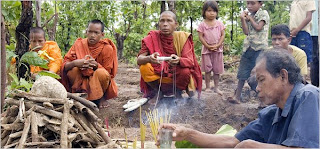Ghosts Wail as Cambodians Plunder Killing Field Graves
 SRE LEAV, Cambodia — Researchers are examining a long-unknown killing field in Cambodia with the graves of thousands of victims of the Khmer Rouge from the 1970s.
SRE LEAV, Cambodia — Researchers are examining a long-unknown killing field in Cambodia with the graves of thousands of victims of the Khmer Rouge from the 1970s.The New York Times
Sre Leav’s mass graves may be the first in Cambodia to be looted.
But local villagers found it first. By the time the researchers arrived in early May, some 200 graves had been dug up and the bones scattered through the woods by hundreds of people hunting for jewelry.
“Everyone was running up there to dig for gold, so I went too,” said Srey Net, 50, describing what seems to have been a communal frenzy that seized this poor and isolated village. “If they can dig for gold, why can’t I?”
It was the first such raid the researchers had recorded in the thousands of burial grounds they have documented around the country. Altogether 1.7 million people died from 1975 to 1979 from starvation, overwork and disease as well as torture and execution.
“People said, ‘This goose has no owner,’ ” said Ouk Souk, 60, a farmer. Few valuables were in the graves, but villagers took whatever they could find.
The invasion of what has been almost sacred ground suggests that past traumas are starting to fade even as Cambodia prepares to begin a long-delayed trial of some Khmer Rouge leaders, said Youk Chhang, a leading expert on the period.
“I think it has become a memory, rather than a physical thing any longer,” he said, speaking of the pain of the past. “There will be no more tears. There are no more feelings to express. Only a flash of memory when you see a piece of bone.”
For younger Cambodians, who know remarkably little about the Khmer Rouge period, he said, “It’s just a dead person.”
Youk Chhang heads the Documentation Center of Cambodia, which has researched the killing fields and amassed a huge archive on the Khmer Rouge years. Visiting here on Thursday, two of his investigators said there could be as many as 9,000 bodies buried in the woods behind this village 100 miles south of Phnom Penh.
Though the pain of the past may have faded, the bones and the ghosts of Khmer Rouge victims still terrify many rural people. After the assault on the burial ground, this little village seemed filled with remorse and dread.
The digging has stopped and several people said they had been awakened at night by screams from the graves.
“People heard voices calling out, ‘Help me! Help me!’ ” said Svay Saroeun, 50, a deputy village chief. “Maybe they are angry at the villagers for digging up their graves. Or maybe they were tortured to death, and now they are being tortured again by people who are disturbing their sleep.”
Srey Noeun, 47, a farmer with four small children, said she could not sleep for three nights after digging two small gold earrings out of a grave.
“I’m afraid that the owner will take revenge on me because she died with nothing but her earrings and now I have taken them,” Srey Noeun said. “She’ll say, ‘Please give them back. They are all I had.’ ”
Ms. Srey Noeun said she sold the earrings as quickly as she could and bought things that she really needed: four pounds of pork, a sack of rice, oil for cooking and for oil lamps, salt, pepper, seasoning and milk powder for her youngest child.
“We never have enough rice,” she said. “Normally we can’t afford to buy pork.”
The buried treasure seemed paltry after nearly a week of digging: one gold necklace and 27 small gold earrings. But it was dazzling to people who live without electricity or running water, far from the nearest clinic, school or paved road.
The luckiest villager was Pen Chia, 27, who recovered the necklace and sold it to buy a cow. But most people found nothing but shattered skulls, bits of bone that looked like broken sticks and scraps of moldering clothing.
“I dug all day without eating,” said Pron Sythoeun, 36, a farmer. “I dug for four days. And I got nothing.”
He has gone back to poke through the scraps with a stick, but few other villagers have returned except to light incense and pray for forgiveness from the restless souls.
The killing field sits empty now in the pouring rain, cratered with shallow pits and mounds of freshly turned red mud, silent under the trees except for the lowing of thin white cattle in a nearby field.
Some villagers said they had not known it was there, although its existence had not been a secret. It was beside them through the decades, like the suppressed traumas of the past, a blank spot in their minds.

0 Comments:
Post a Comment
Subscribe to Post Comments [Atom]
<< Home